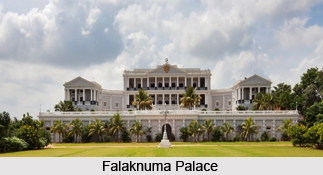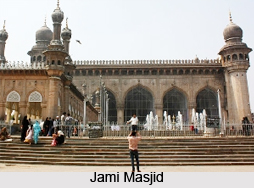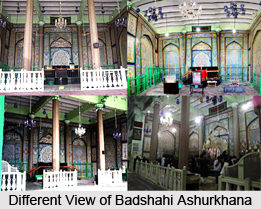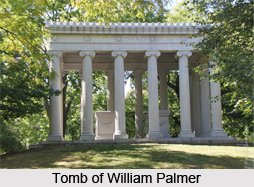 The religious monuments of Hyderabad have mostly been constructed by the Nizams of Hyderabad. Since they were ardent followers of Islam, most of the monumental constructions here are Islamic in style and belief. A number of mosques, masjids and tombs are found in Hyderabad.
The religious monuments of Hyderabad have mostly been constructed by the Nizams of Hyderabad. Since they were ardent followers of Islam, most of the monumental constructions here are Islamic in style and belief. A number of mosques, masjids and tombs are found in Hyderabad.
The Mecca Masjid is located immediately to the South West of the Char Minar, on the road to Falaknuma Palace. Its construction was started in 1614 by Muhammad Qutab Shah and completed by Aurangzeb twenty years later. An engraved tablet marks the date. The main entrance, built in 1692, had four minars and five arches to the front. This forms one side of a paved quadrangle laid out in 1614. To the north and south sides arc two symmetrical domes over 30-5 m (100 ft) above roof level. Built in local granite, it is one of the largest mosques in India. Each column is hewn from a single stone. The small red stones in the central arch are made of earth from Mecca.
The tombs of all the Nizams of the Asaf Jahi dynasty from 1803 are contained in an arched gallery at the south end of the mosque.
 The Jami Masjid was built in 1598 in the typical Qutab Shahi style. It is situated east of the main road. It was later renovated under Asaf Jah III. Ruins of a school and bath-house can still be seen here.
The Jami Masjid was built in 1598 in the typical Qutab Shahi style. It is situated east of the main road. It was later renovated under Asaf Jah III. Ruins of a school and bath-house can still be seen here.
The Kali Masjid with its three massive arches is an interesting small mosque in the transitional style between the Qutb Shahi and Asaf Jahi styles of architecture. It was built by Rustum Dil Khan in memory of his father, Jan Supar Khan. Their tombs lie in the compound outside; that of Rustum Dil Khan is black basalt with pierced trelliswork, his father`s is plain ashlar.
A large Muslim cemetery, the Dargah Hazrat Brahna Shah Saheb, is located 4 miles east of the city in Edi Bazaar. It is named after a follower of Sufi Sarman.He died in Hyderabad in 1663. A large tomb was erected by one of his disciples and around this a vast graveyard has grown. It is an interesting repository of Muslim funerary architecture.
The Daira Mir Momin is a cemetery containing a number of important tombs. Mir Momin, Prime Minister under Muhammad Quli Qutb Shah, was buried here in 1625 in a polished black basalt tomb. Mir Alam, Salar Jung I, II, III, Siraj-ul-Mulk and other high-office holders are also interred here.
The Azha Khana-e-Zahra is an old mourning house built by Asaf Jah VII in memory of his mother. It is located between the Salar Jung and Purana Haveli roads.
The Badshahi Ashurkhana or the royal house of mourning, one of the few surviving buildings from Muhammad Quli Qutb Shah`s original layout and one of the oldest imambaras in India. The inner hall is in Qutb Shahi style. The outer, enriched with timber colonnades, was added by Nizam Ali Khan. The enamel tile mosaics in Persian style are some of the best of their kind comparable to those of Lahore and Multan.
Apart from the mosques and tombs, a few Hindu temples are also found among the monuments of Hyderabad.
The Lord Venkateshwara Swamy Temple is dedicated to Lord Balaji Venkateshware.It is located at Chilkur, 25 km from Hyderabad, on the banks of the Osman Sagar lake. This magnificent temple was built in the tradition of the South Indian temple architecture. . The temple was built by Akkanna and Madanna, the uncles of Vhakta Ramdas. It houses some of the most worshipped Hindu deities including Lord Padmavathi, Lord Andal, Lord Ganesha and Lord Anjaneya.
Kishan Bagh Temple and Dargah was built in 1822 by Raja Raghu Ram Khatri.This temple, situated near the Nehru zoological park, has a consecrated idol of the Lord Krishna. A annual ritual is performed in the temple on a full moon day. This is attended by thousands of devotees. During the rule of the Nizams, a Jagir yielding an annual income of eight thousand rupees was granted for the temple.
Right adjacent to the temple is the Dargah of Syed Shah Nazamullah Russani, a Muslim saint.
A Christian school and church also rank among the monuments of Hyderabad. The presence of Christian institutions in a chiefly Islamic state can be attributed to the presence of the British here. The European dimension was added to the cosmopolitan nature of the city by way of the establishment of the British residency here.
The St. George`s grammar school and church was founded in 1834.The school has a simple arcaded stucco range with a segmental pediment over the entrance.
St George`s Church (1865-7) is a conventional essay in a simple Gothic style with crenellations and a single west tower.
Tombs of some of the renowned British officers are also to be found here.
The tomb of Michel Raymond (1798) is found East of Oliphant Bridge at Malakhpet.Raymond was the Raymond was the figurehead of French ambitions in central India, having risen to the position of Commandant in the Nizam`s army, with a force of over 15,000. His tomb is of polished grey granite on an elevated masonry platform. The four sides of the obelisk arc inscribed `J. R.`; in front of it is a small flat-roofed Grecian-style building carried on columns, which is illuminated by lamps on the anniversary of his death.
The Tomb of William Palmer (1867), is also found here. He was head of Palmer & Co., the bankers, the son of General Palmer and the Begum of Oudh. His tomb is in the Muslim style.
There is also a cemetery to be found here. It has some interesting well-preserved tombs, including those of four Residents. Found here are the tombs of Lieutenant W. J. Darby (1815), the tomb of George Rumbold (1820) and that of the notorious Sir William Rumbold (1833) after whom the Rumbold`s Kothi is named.



















